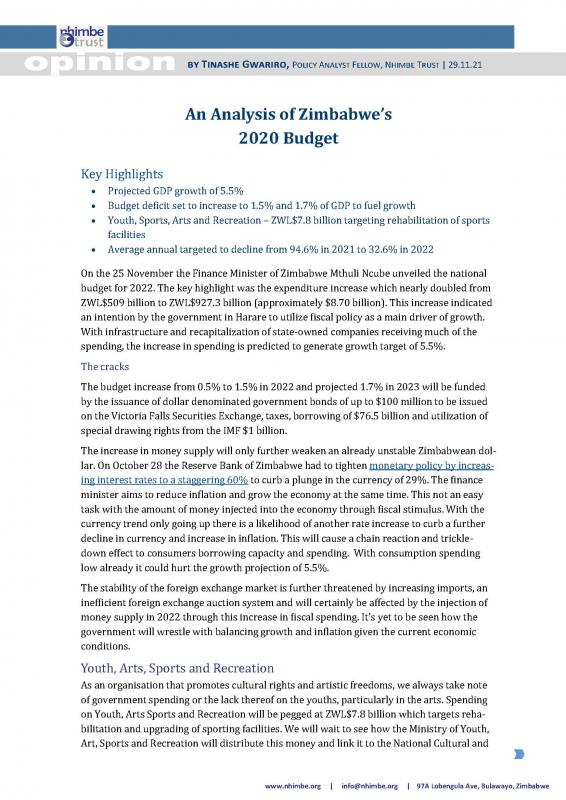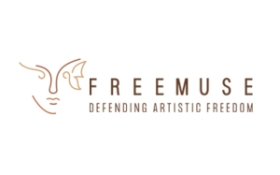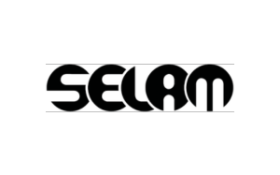Key Highlights
- Projected GDP growth of 5.5%
- Budget deficit set to increase to 1.5% and 1.7% of GDP to fuel growth
- Youth, Sports, Arts and Recreation – ZWL$7.8 billion targeting rehabilitation of sports facilities
- Average annual targeted to decline from 94.6% in 2021 to 32.6% in 2022
On the 25 November the Finance Minister of Zimbabwe Mthuli Ncube unveiled the national budget for 2022. The key highlight was the expenditure increase which nearly doubled from ZWL$509 billion to ZWL$927.3 billion (approximately $8.70 billion). This increase indicated an intention by the government in Harare to utilize fiscal policy as a main driver of growth. With infrastructure and recapitalization of state-owned companies receiving much of the spending, the increase in spending is predicted to generate growth target of 5.5%.
The cracks
The budget increase from 0.5% to 1.5% in 2022 and projected 1.7% in 2023 will be funded by the issuance of dollar denominated government bonds of up to $100 million to be issued on the Victoria Falls Securities Exchange, taxes, borrowing of $76.5 billion and utilization of special drawing rights from the IMF $1 billion.
The increase in money supply will only further weaken an already unstable Zimbabwean dollar. On October 28 the Reserve Bank of Zimbabwe had to tighten monetary policy by increasing interest rates to a staggering 60% to curb a plunge in the currency of 29%. The finance minister aims to reduce inflation and grow the economy at the same time. This not an easy task with the amount of money injected into the economy through fiscal stimulus. With the currency trend only going up there is a likelihood of another rate increase to curb a further decline in currency and increase in inflation. This will cause a chain reaction and trickle-down effect to consumers borrowing capacity and spending. With consumption spending low already it could hurt the growth projection of 5.5%.
The stability of the foreign exchange market is further threatened by increasing imports, an inefficient foreign exchange auction system and will certainly be affected by the injection of money supply in 2022 through this increase in fiscal spending. It’s yet to be seen how the government will wrestle with balancing growth and inflation given the current economic conditions.
Youth, Arts, Sports and Recreation
As an organisation that promotes cultural rights and artistic freedoms, we always take note of government spending or the lack thereof on the youths, particularly in the arts. Spending on Youth, Arts Sports and Recreation will be pegged at ZWL$7.8 billion which targets rehabilitation and upgrading of sporting facilities. We will wait to see how the Ministry of Youth, Art, Sports and Recreation will distribute this money and link it to the National Cultural and Creative Industries 2020-2030 strategy and leverage the economic potential that the sector can bring. Given the minuscule allocation that has been budgeted, the arts sector will still have to rely on their own enterprising and innovative efforts to grow with minimum government support.
At Nhimbe Trust we have had the privilege of participating in the Ministry of Youth, Arts, Sports and Recreation 2022 STRATPLAN to develop a performance contract to monitor the Permanent Secretary’s priorities. Nhimbe Trust will use the Bill Tracker to monitor 2022 National Budget contribution towards the Arts and Culture Development Fund, as the budge seeks to “support the implementation of the Cultural and Creative Industries Strategy 2020-2030, the National Budget is establishing an Arts Fund with initial seed capital amounting to ZWL$100 million”. The Bulawayo Arts Festival of the City of Bulawayo was supported by the Arts Fund, and we hope this support will continue in 2022.
2022
The governments’ ambitious attempts to restart the economy can be commended but the country still has multiple fundamental problems that have not been resolved. With a lack of trust in the financial system, to runaway inflation, a lack of concrete economic strategies, COVID’s impact on global supply chains and new variants presenting threats of future lockdowns, it will be interesting to see if that 5.5% growth will be achieved.






